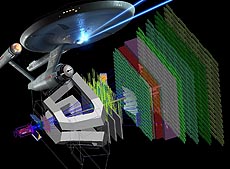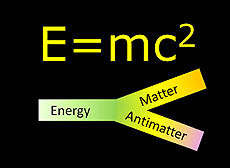What's the deal with antimatter?
 |
| Antimatter can be found in science fiction and in fact. It both powers fictional starships and is associated with one of the most perplexing mysteries in modern physics. Since our theories suggest that matter and antimatter should have been made in equal quantities, yet we observe only matter, this mystery is really quite fundamental: Why are we here at all?
|
View a video on antimatter.
Star Trek taught us that if we want to go blasting all over the galaxy, we need to harness the power of antimatter. Of course it also taught us about dilithium crystals, Vulcan neck pinches and Klingon blood wine. Is there any reason to think that antimatter is any less fictional than these other outlandish ideas?
In 1928, Paul Dirac predicted the existence of antimatter when he successfully merged Einstein's theory of special relativity with quantum mechanics. His equations had two solutions. One explained ordinary matter while the other solution was the negative of the first. After people proposed a few ideas as to what the second solution meant, the situation became greatly clarified in 1932 with Carl Anderson's discovery of antimatter high in the Colorado Rockies.
Antimatter is a science fiction topic that is entirely science and not at all fiction. So what is it? It's actually not much different from ordinary matter. There are antiquarks, antileptons, antiprotons, antineutrons and antielectrons. If we had a bunch of these antiparticles, we could make anti-atoms and indeed an entire anti-universe. To the best of our knowledge, this universe would have identical chemistry as our own. We even have some supporting evidence for this, as anti-hydrogen and anti-helium have been created.
Things get trickier when ordinary matter and antimatter are placed in contact with one another. When they are, they annihilate each other, resulting in a huge amount of energy. This is actually extremely easy to see; all you need is the familiar equation E = mc2. E refers to some amount of energy and m refers to a related amount of matter (or antimatter). The c2 term is just a constant…actually a very big constant. In the metric system, which is the commonly used system for scientific calculations (and neglecting units), c2 = 90,000,000,000,000,000. A tiny amount of matter, say a gram, multiplied by a very big constant tells you that it can produce a huge amount of energy. Thus something with the mass of a paper clip touching an identical amount of antimatter would release the same amount of energy as the first atomic explosion at the Trinity site in New Mexico. It could also produce enough energy to lift a space shuttle to orbit 20 times. The plot device in Dan Brown's Angels and Demons is physically possible.
Physically possible, perhaps, but practically impossible. Fermilab's antiproton source made more antimatter over its quarter-century of operations than any other facility. Yet if you took all of the antimatter ever made and combined it with matter, the energy release would warm about 5 gallons of coffee from room temperature to something drinkable. Making antimatter is really hard. So how do you make antimatter after all? It's not like you can buy it at the store. The way you make antimatter is to exploit Einstein's E = mc2 equation in reverse. If you take a tremendous amount of energy, you can make matter and antimatter in equal (minuscule) quantities. You then collect and store the antimatter using electric and magnetic fields to ensure the antimatter stays in a vacuum so it doesn't encounter any matter at all.
 |
| Antimatter and matter are antagonistic substances that can annihilate into energy. Conversely, energy can make matter and antimatter in equal quantities. The fact that our universe is made entirely of matter is not understood.
|
If antimatter and matter are made in equal quantities, then we have a problem. In the early universe, the cosmos was filled with energy. As the universe expanded and cooled, the energy converted into identical amounts of matter and antimatter. And yet the universe we inhabit appears to be made entirely of matter. So where did all the antimatter go?
This is a good question, and we don't have a good explanation yet. It appears that very early in the history of the universe, just a fraction of a second after it began, an unknown mechanism caused a very, very small imbalance. For every 1,000,000,000 antimatter particles, there were 1,000,000,001 matter ones. The billion matter and antimatter particles annihilated, leaving the tiny trace of leftover matter from which our cosmos was built.
In 1957, physicists discovered that the weak nuclear force treated matter and antimatter differently. They were able to tidy up that particular loose thread by invoking the principle that our equations still worked if, whenever we exchanged matter with antimatter, we also swapped left and right. This observation returned order to our thinking until 1964, when another experiment showed that the universe didn't cooperate. There were cases in which matter and antimatter were acted upon differently.
But the number of differences was insufficient to explain our universe. In the ensuing decades, additional measurements, including important ones at the Tevatron, have helped clarify the situation. However, it remains true that we still don't understand why our universe is made of matter. There are certainly a lot of experiments looking into it. The LHCb experiment at CERN is specifically designed to study this question in detail, although the ATLAS and CMS experiments will also have plenty to say on the subject. In addition, CERN's ALPHA experiment traps antimatter for long periods of time (over 10 minutes) to study it. Another approach uses the AMS (Alpha Magnetic Spectrometer) experiment on the International Space Station to study the cosmic presence of antimatter. It is fair to say that the antimatter asymmetry is one of the central questions of particle physics today.
—Don Lincoln
Want a phrase defined? Have a question? E-mail today@fnal.gov.
|